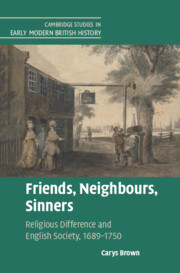Friends, Neighbours, Sinners
Friends, Neighbours, Sinners demonstrates the fundamental ways in which religious difference shaped English society in the first half of the eighteenth century. By examining the social subtleties of interactions between people of differing beliefs, and how they were mediated through languages and behaviours common to the long eighteenth century, Carys Brown examines the graduated layers of religious exclusivity that influenced everyday existence. By doing so, the book points towards a new approach to the social and cultural history of the eighteenth century, one that acknowledges the integral role of the dynamics of religious difference in key aspects of eighteenth-century life. This book therefore proposes not just to add to current understanding of religious coexistence in this period, but to shift our ways of thinking about the construction of social discourses, parish politics, and cultural spaces in eighteenth-century England.
- Proposes new ways of thinking about social discourses and cultural spaces in eighteenth-century England
- Explores the evolution, persistence, and impact of the religious stereotypes of England's long Reformation
- Draws on a range of contemporary print, diaries, correspondence, and court records, as well as the meeting papers of Protestant groups
Reviews & endorsements
'This book is … not only valuable for historians of religion seeking to understand the social, local and personal effects of 1689, but it is also a helpful reminder for social and cultural historians of the centrality of religion to the way that eighteenth-century individuals perceived one another.' Daniel Rignall, The Proceedings of the Wesley Historical Society
‘The book provides not only a useful argument for a more complex understanding of the role of religion in eighteenth-century England, but also a model for how to think about it in the wider English world.’ Evan Haefeli, Journal of British Studies
‘Brown’s study offers compelling evidence of the tensions prompted in individuals and groups by the act’s dissonant promise of security for and acceptance but not outright approval of sectarian dissent.’ Daniel Lochman, H-Net Reviews
‘This book presents an often overlooked way of examining social history and it has value for that. How did neighbours interact, especially given such profound differences sincerely held by both parties? The physical presence of alternative places of worship within a parish served as a daily reminder of difference but did not necessarily lead to confrontation. How were such differences tackled and even resolved? Carys Brown addresses the social discourse, and the local politics and culture of the community at that time in this valuable study.’ Marian Field, Congregational History Society Magazine
Product details
August 2022Hardback
9781009221382
330 pages
235 × 156 × 22 mm
0.59kg
Available
Table of Contents
- Introduction
- 1. Reframing religious difference
- 2. Public religion
- 3. Politeness and hypocrisy
- 4. Drinking, dancing, talking
- 5. Neighbours, friends, company
- Conclusion.






